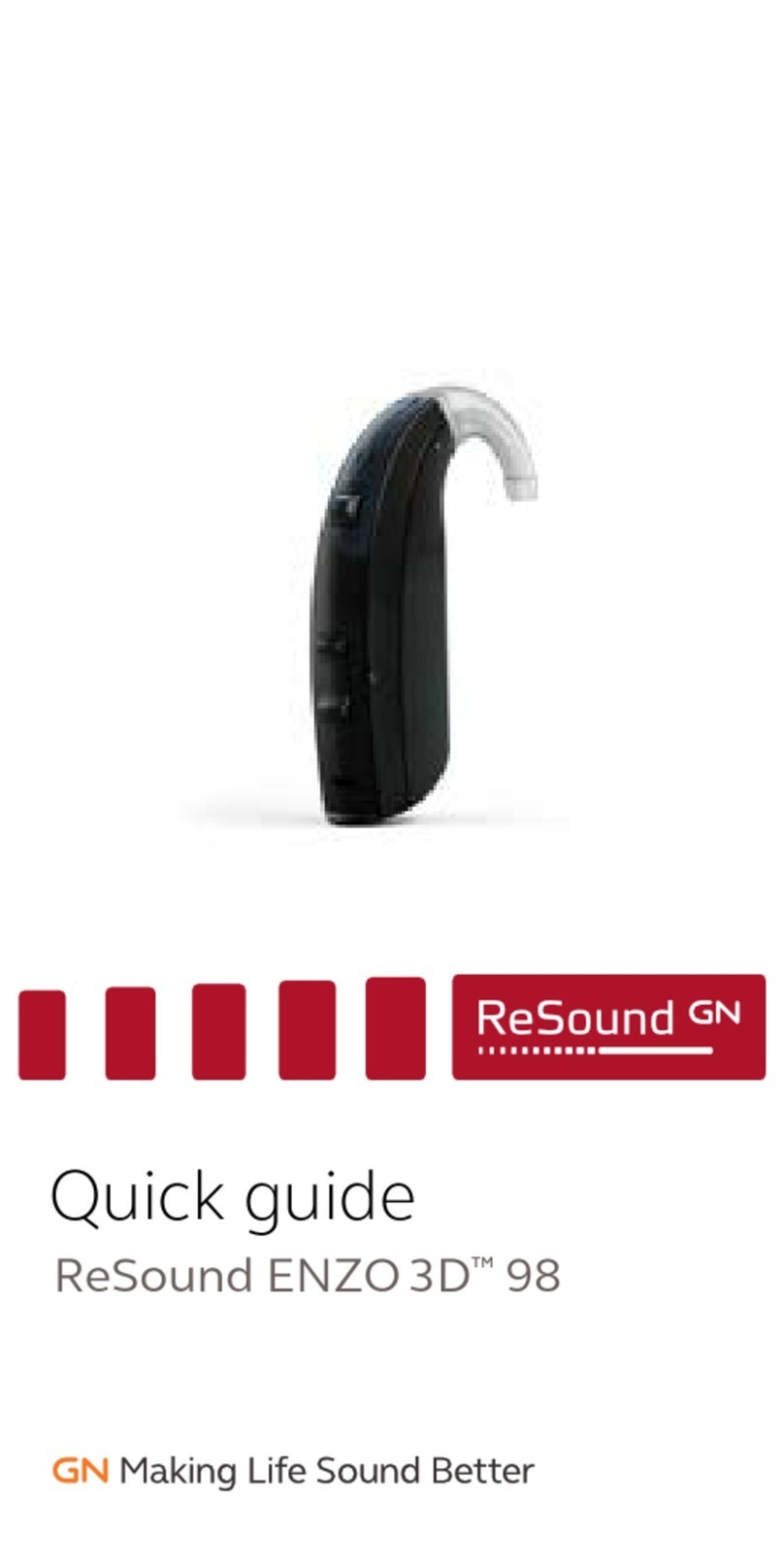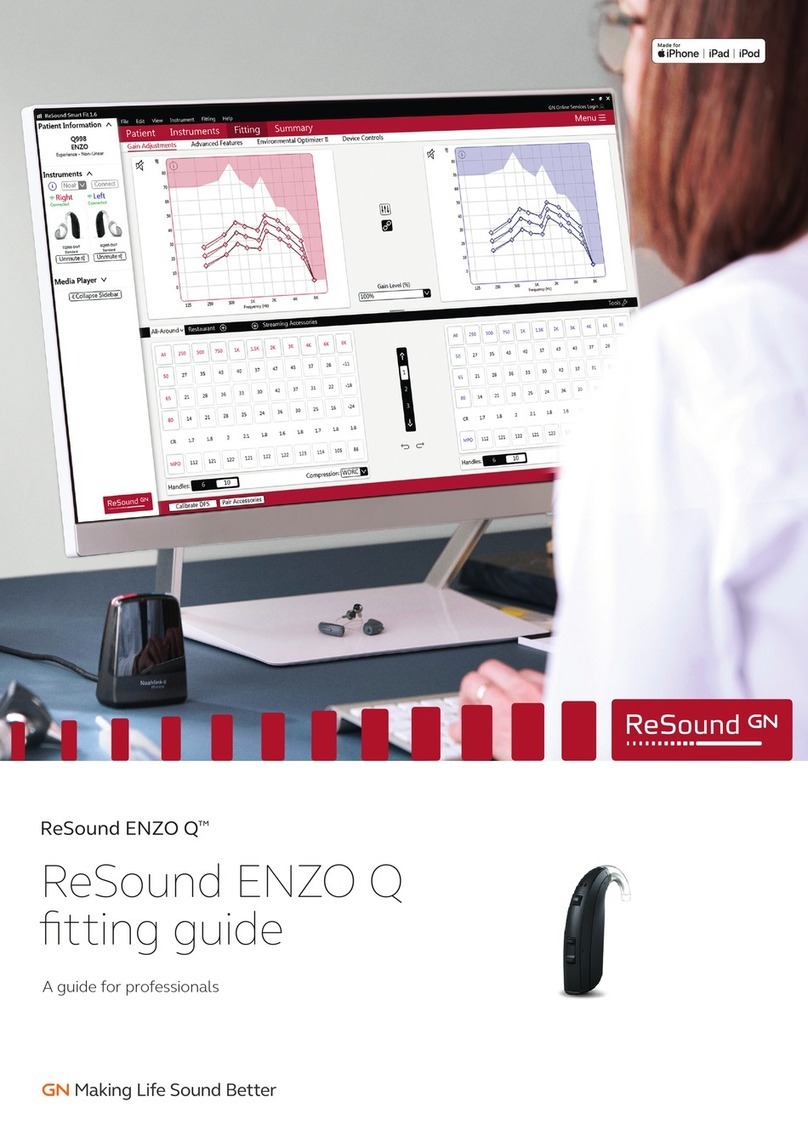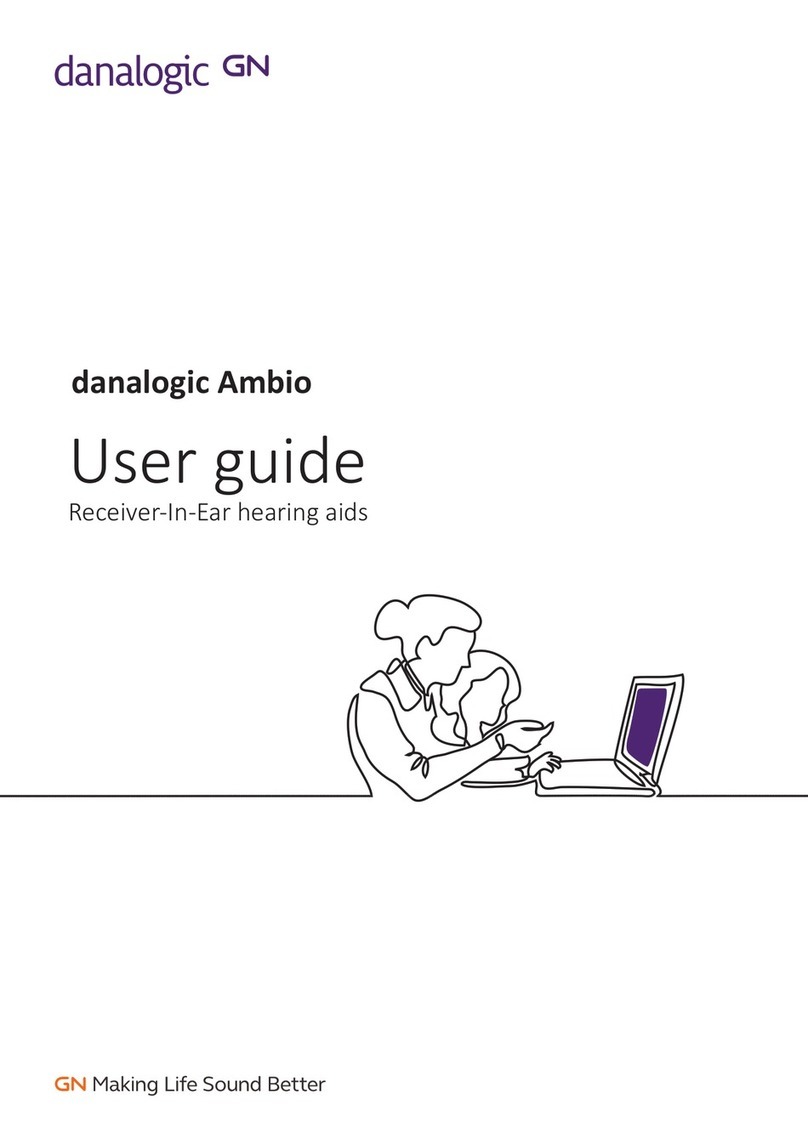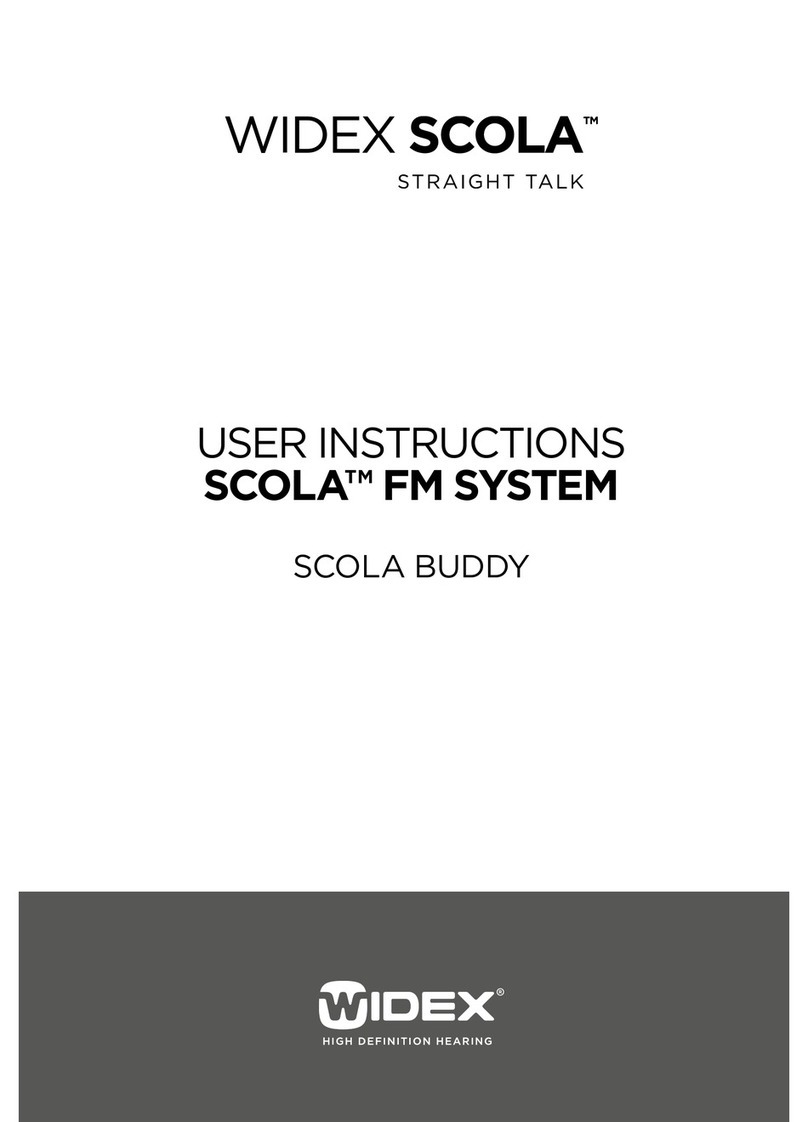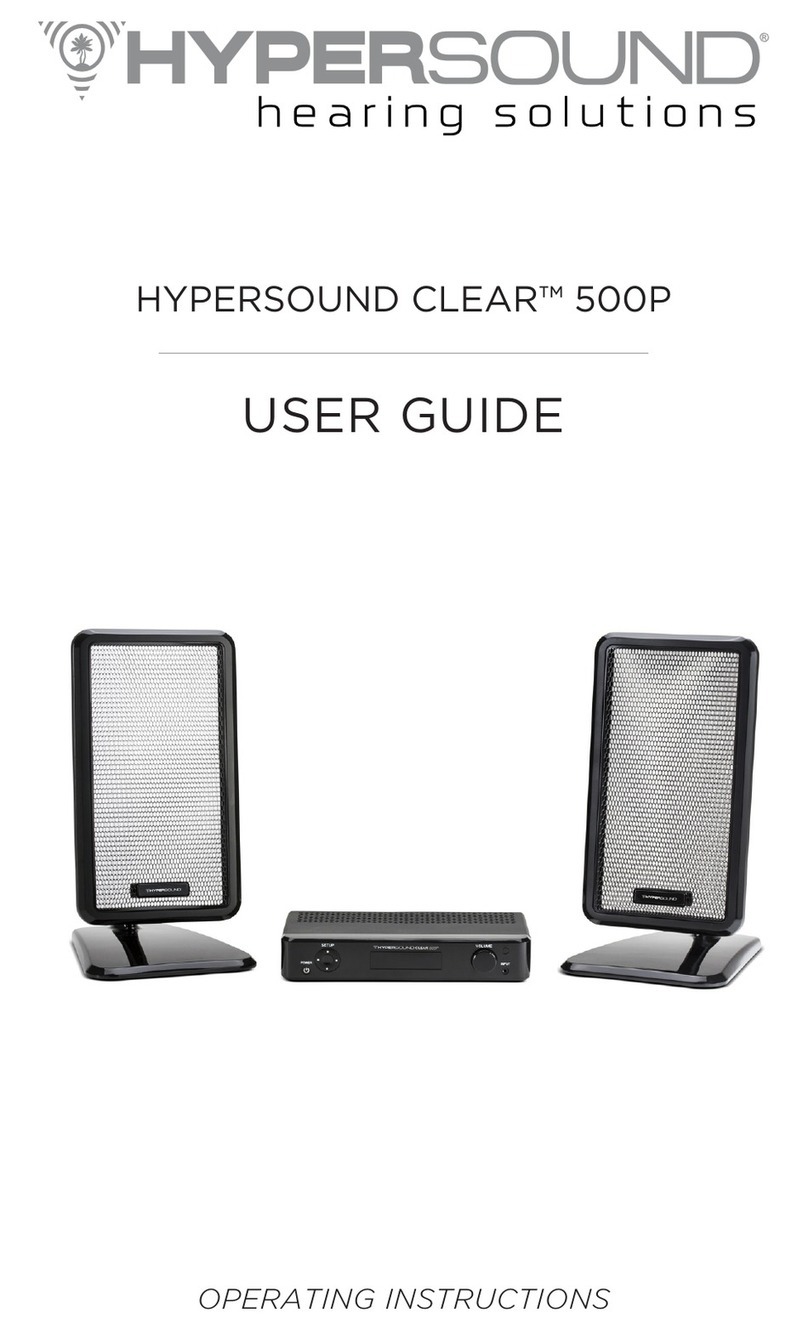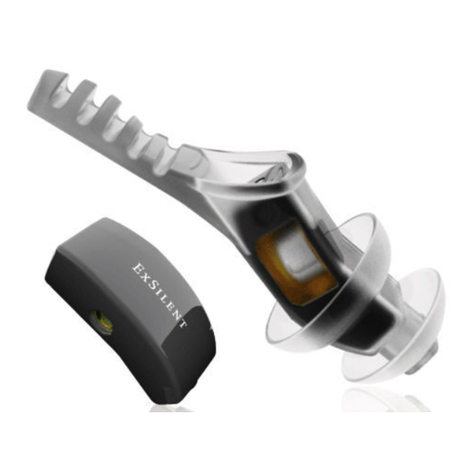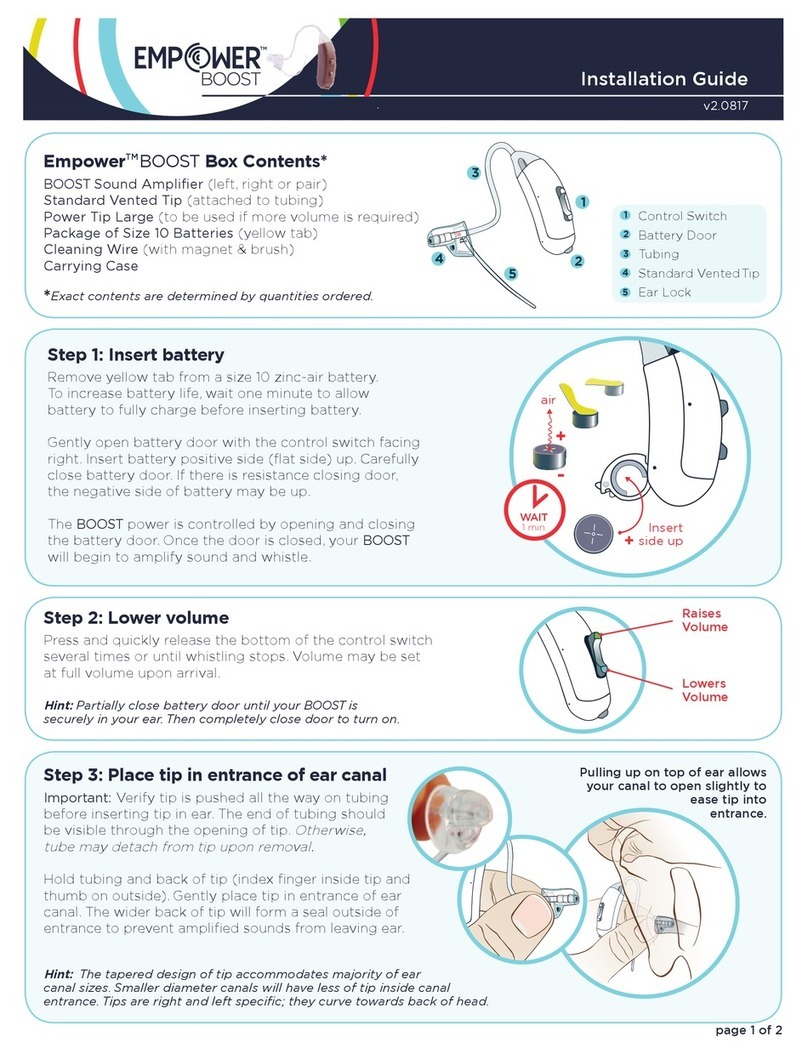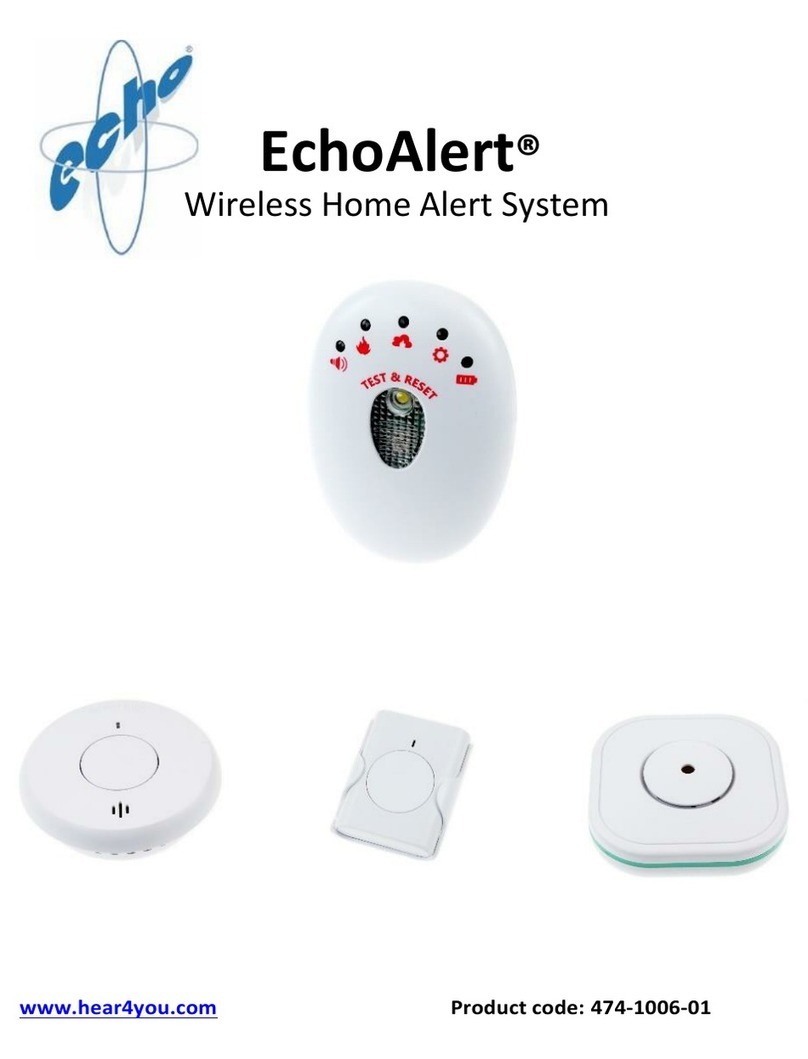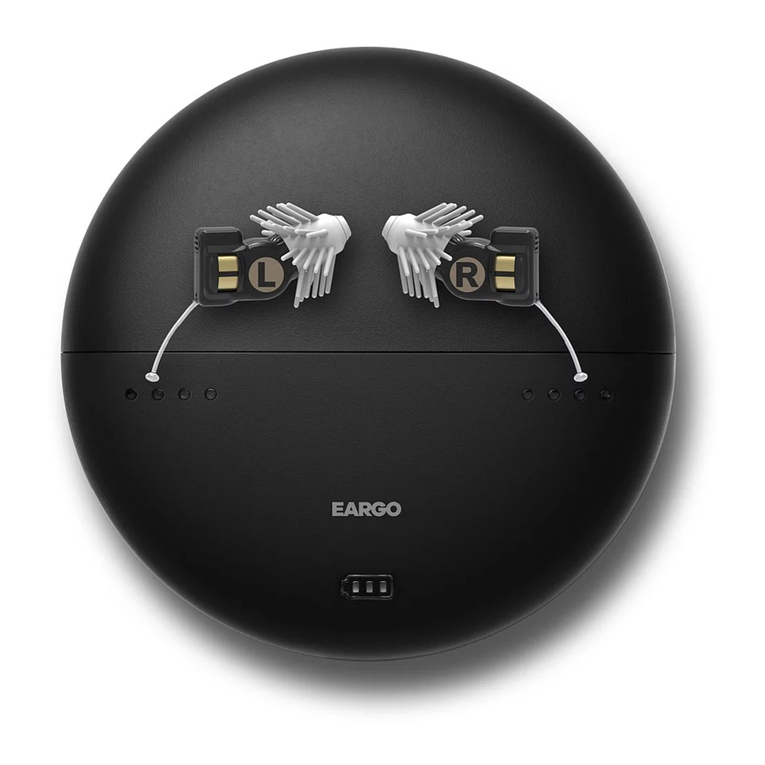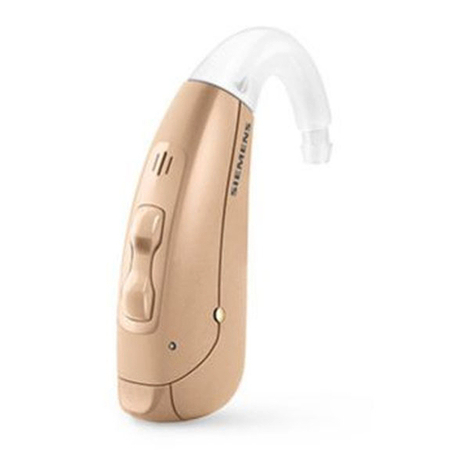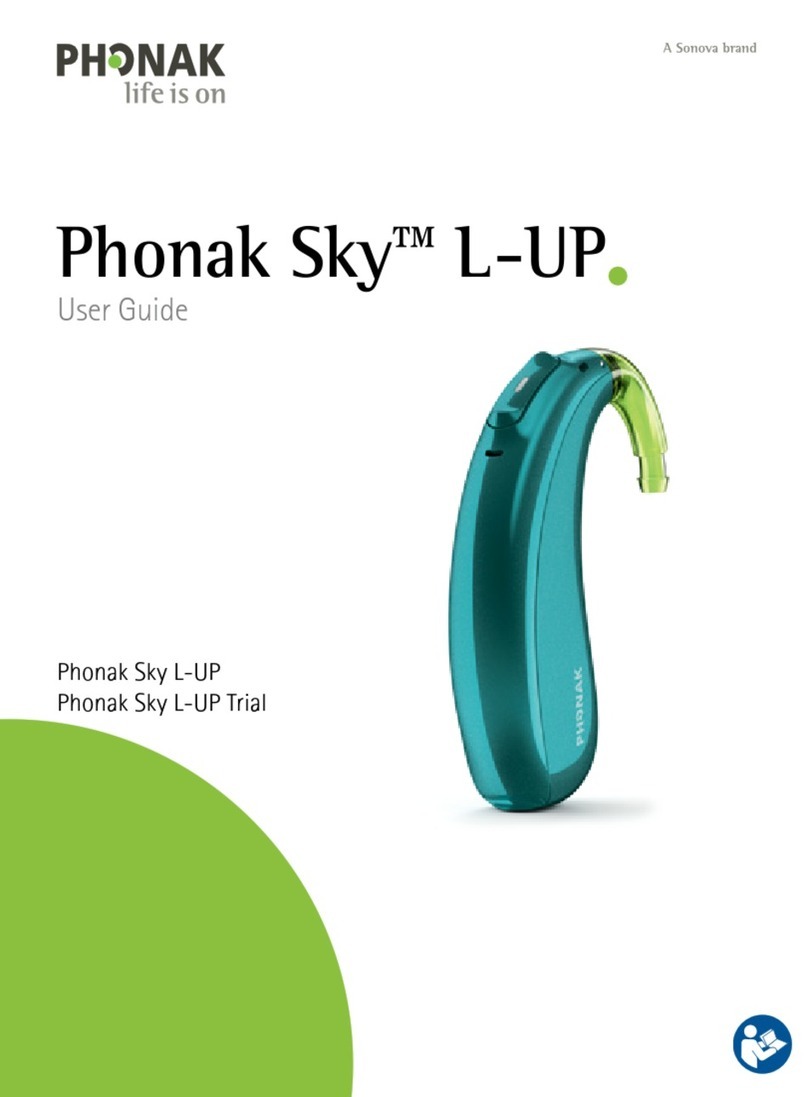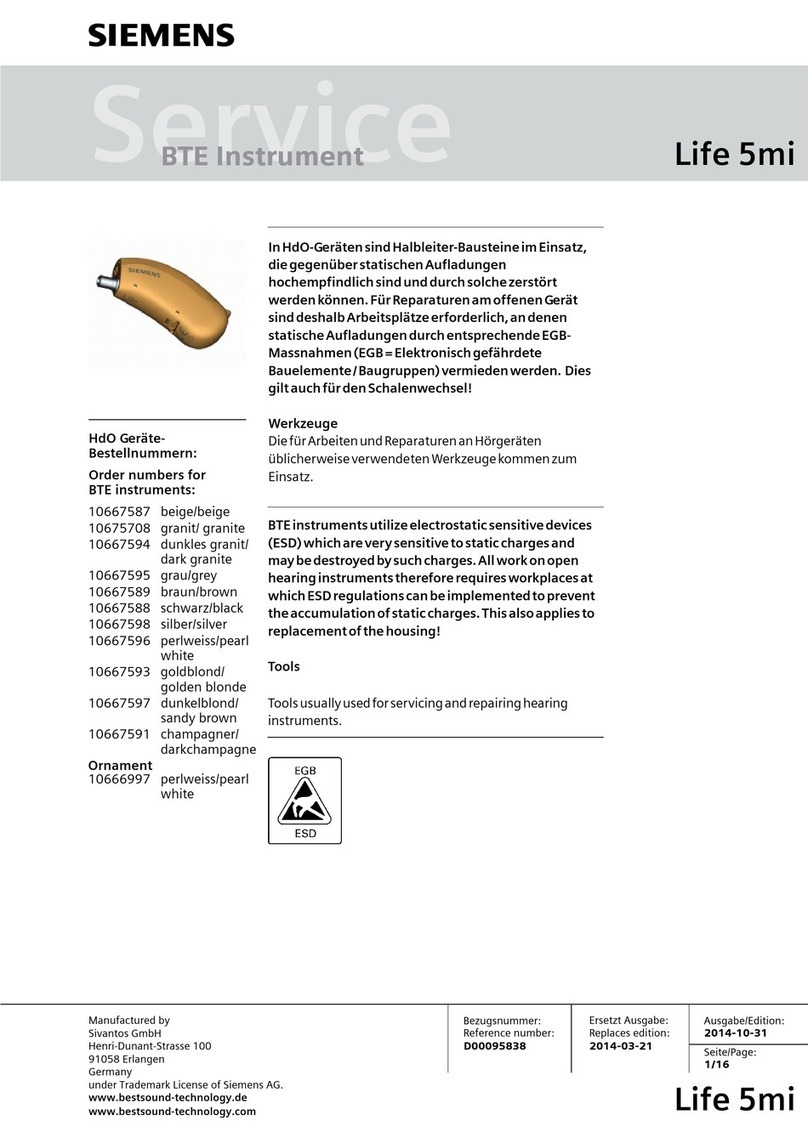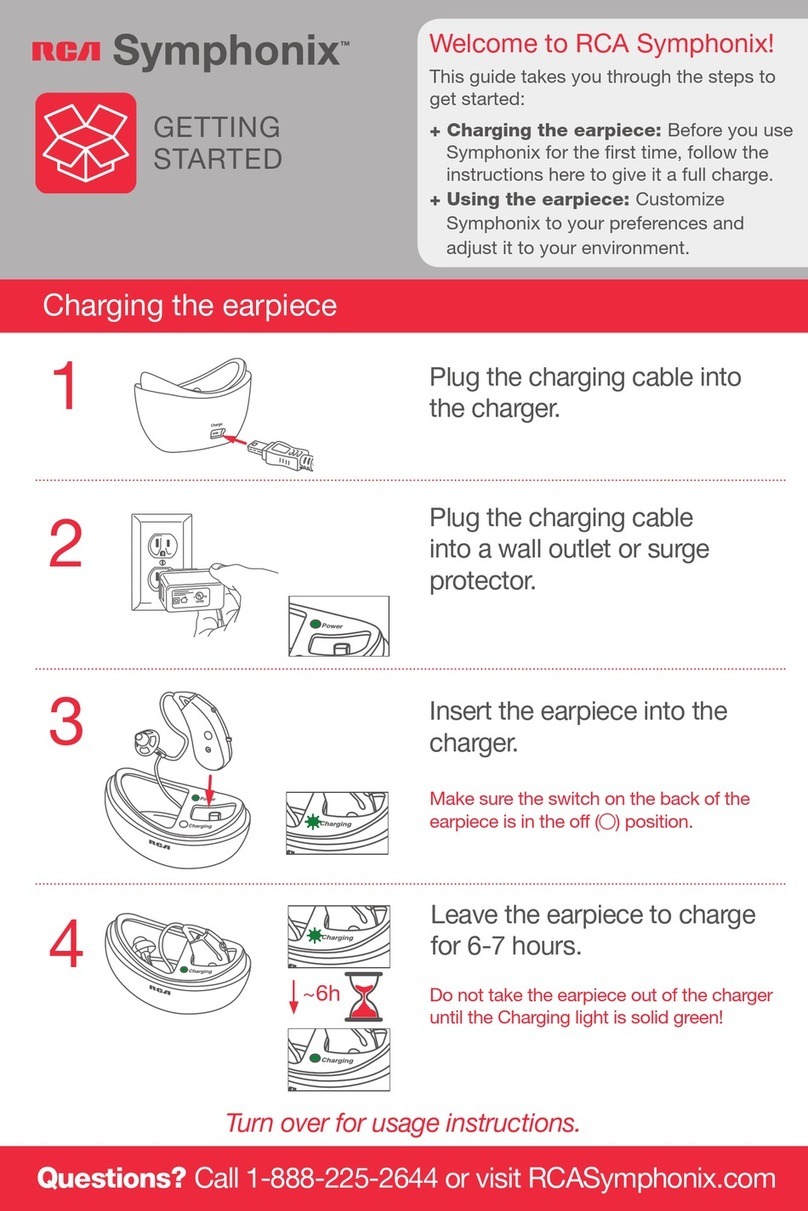GN ReSound KeyCSX12 User manual

User guide
ReSound Custom hearing aids

Hearing aid information
Left hearing aid Right hearing aid
Serial number Serial number
Model number Model number
Battery type £CIC size 10A
oITC, ITE size 312
£ITE size 13
Program Beep Description
1 One beep
2 Two beeps
3 Three beeps
4 Four beeps
2

Table of Contents
Introduction 5
Your hearing aid 6
How to get your hearing aid ready for use 8
How to place the hearing aids in your ears 13
How to remove the hearing aids from your ears 15
How to use your hearing aids 17
Using a telephone 23
Advanced options 28
Wireless accessories 33
How to clean and maintain your hearing aids 35
General warnings and precautions 38
Hearing aid expectations 41
Troubleshooting 42
Warnings to Hearing Aid Dispensers (US only) 44
Tinnitus Management 47
Regulatory information 62
Additional information 70
3

4

Introduction
Thank you for choosing our hearing aids. We recommend that you use your hearing aids every day.
This way you will fully benefit from them.
NOTE: Read this booklet carefully before you start using your hearing aids.
Intended use
Generic air-conduction hearing aids are wearable sound-amplifying devices intended to compensate
for impaired hearing. The fundamental operating principle of hearing aids is to receive, amplify, and
transfer sound to the eardrum of a hearing impaired person.
For devices including a Tinnitus Sound Generator module
The Tinnitus Sound Generator module is a tool to generate sounds to be used in a Tinnitus
Management Program to temporarily relieve patients suffering from Tinnitus.
Introduction 5

Your hearing aid
Your hearing aid – Completely-In-the-Canal (CIC)
1. Push button (optional)
2
7
10
4
1
3
5
Manufacturer
XXXX
8
9
3
6
10
2. Battery door and On/Off switch
3. Removal cord (optional)
4. Sound outlet
5. Wax filter
6. Vent
7. Microphone inlets
8. Manufacturer
9. Model designation and Serial number
10. Antenna
6Your hearing aid

Your hearing aid – In-The-Canal (ITC)/In-The-Ear (ITE)
1. Microphone sound inlets
21
1
5
4
3
2. Push button (optional)
3. Battery door
4. Volume control (optional)
5. Vent
Your hearing aid 7

How to get your hearing aid ready for use
Replacing the battery
1. Open the battery door completely by using your fingernail. Remove
the used battery if present.
2. Prepare the new battery. Remove the protective foil to activate the
battery. Wait for 2 minutes before inserting the battery into the
hearing aid.
8How to get your hearing aid ready for use

3. Insert the new battery with the positive side in the correct position.
Always insert the battery in the door: never directly into the hearing
aid. Gently close the battery door.
NOTE: Always use new zinc-air batteries that have a minimum remaining shelf life of one year.
When the hearing aid is not in use, open the battery door to turn it off. Open the battery door completely
to allow moisture to evaporate and prolong the hearing aids’ lifespan.
If the hearing aids are experiencing frequent loss of connection to wireless accessories, contact your
hearing care professional for a list of low impedance batteries.
Battery warnings
• Zinc-air batteries can be harmful to your health:
– Do not place batteries in your mouth.
How to get your hearing aid ready for use 9

– Consult a physician immediately if a battery has been swallowed, as they can be harmful to your
health.
– Keep batteries away from children, mentally disabled persons, and pets.
• Batteries may leak. Remove the battery if you leave the hearing aids unused for longer periods.
• Do not recharge zinc-air batteries – they may leak or explode.
• If the batteries are not inserted correctly, the device will not work and the batteries may build up
heat. If this happens, please remove the batteries.
• Do not attempt to dispose of batteries by burning them.
Used batteries are harmful to the environment. Please dispose of them according to local
regulations or return them to your hearing care professional.
NOTE: Always use new zinc-air batteries that have a minimum remaining shelf life of one year.
Low battery warning
When the batteries are low on power, your hearing aids reduce the volume, and play a melody every
15minutes, until they are empty and turn off.
NOTE: Keep spare batteries on hand.
10 How to get your hearing aid ready for use

Low battery warning when paired with wireless accessories
(optional)
NOTE: The batteries drain faster when you use wireless functionalities like streaming from your
smartphone or from your TV via our TV streamer. As the battery power goes down, the wireless
functions stop working. A short melody every five minutes indicates that battery power is too low.
The table below shows how the hearing aid functions are affected as the power level declines.
If the hearing aids are experiencing frequent loss of connection to wireless accessories, contact
your hearing care professional for a list of low impedance batteries.
How to get your hearing aid ready for use 11

Battery level Signal Hearing aid Remote control Streaming
Fully charged P P P
Low
4 even tones
P P x
Depleted
3 even tones and
1 longer tone
Px x
These will work again when you insert a new battery.
12 How to get your hearing aid ready for use

How to place the hearing aids in your ears
How to tell right from left
If you have two hearing aids, it is important that you can recognise one from the other.
Your right hearing aid will always have a red marking, while your left hearing aid will have a blue
marking.
Insert hearing aids
Insert Completely-In-The-Canal (CIC), In-The-Canal (ITC), and In-The-Ear(ITE)
1. Hold the hearing aid between your thumb and index finger, either
above and below or on the sides.
2. Place the sound outlet portion into your ear canal. Turn the top part
of the hearing aid gently backwards and forwards so that it tucks
behind the fold of skin above your ear canal.
3. Insert the hearing aid into your ear canal. Opening and closing your
mouth may ease insertion.
How to place the hearing aids in your ears 13

By experimenting, you may discover an easier method. With proper insertion, hearing aids should fit
snugly but comfortably.
NOTE: It may be helpful to pull your ear up and outward with your opposite hand during
insertion.
14 How to place the hearing aids in your ears

How to remove the hearing aids from your ears
Remove Completely-In-Canal hearing aids
1. Hold the removal cord with your thumb and index finger and pull
outward.
2. Hold the edges of the hearing aid with your thumb and index finger and
pull out and slightly upward, while slightly rotating your hand forward.
How to remove the hearing aids from your ears 15

Remove In-The-Canal (ITC) and In-The-Ear (ITE)
Hold the edges of the hearing aid with your thumb and index finger and pull
out and slightly upward, while slightly rotating your hand forward.
CAUTION: Never attempt to modify the shape of the hearing aid yourself.
16 How to remove the hearing aids from your ears

How to use your hearing aids
Operation of the hearing aid
The volume control (optional) allows you to adjust the volume of your hearing aids to your liking.
1. To increase the volume, turn the volume control up (+).
2. To decrease the volume, turn the volume control down (-).
When you change the volume, the hearing aid responds with a beep. When you reach the upper or
lower limits, the hearing aid responds with a low-pitch beep.
How to use your hearing aids 17

NOTE: If you have two hearing aids with the Synchronised Volume Control function enabled,
volume control adjustments to one hearing aid automatically repeats in the second hearing aid.
When you change volume on one of the hearing aids, it responds with one or more beeps. A
beep in the second hearing aid follows.
If your hearing aids support wireless remote control, you may use the ReSound Remote Control
2 or the ReSound Smart 3D™ app to adjust e.g. the volume.
Push button (optional)
Your hearing aid has a push button allowing you to use up to four different listening programs. The list
on page 2 tells which programs have been enabled.
1. Push the program button to switch between programs.
2. You will then hear one or more beeps. The number of beeps indicates which program you have
selected (one beep = program one, two beeps = program two, etc.).
3. When you turn the hearing aids off and then back on, they always return to the default setting
(program one and preset volume).
18 How to use your hearing aids

NOTE: If you have two hearing aids with the Synchronised Push Button enabled, program
changes to one hearing aid automatically repeats in the second hearing aid. The same number
of confirmation beeps will follow in the second hearing aid. This Synchronised Push Button can
also be configured to allow one side to control volume increase and the other to control volume
decrease. The volume changes to one hearing aid are repeated on the other side to keep levels
the same.
Telecoil
(Optional for ITC, ITE models only)
Your hearing aid may have a telecoil. The Telecoil function may help to improve understanding of
speech with Hearing Aid Compatible (HAC) telephones and in theatres, cinemas, houses of worship,
etc. that have a teleloop installed.
When you select the Telecoil program, your hearing aid picks up signals from the teleloop or HAC
telephone. Your hearing care professional can activate the Telecoil program.
How to use your hearing aids 19

NOTE: The telecoil does not work without a teleloop (that is, an induction loop) or an HAC
telephone.
If you are having trouble hearing with the telecoil, ask you hearing care professional to adjust the
program.
If there is no sound from your hearing aids in a teleloop system with an active Telecoil function,
the teleloop system may not be turned on or may not be operating correctly.
The sound from the teleloop and the hearing aids' microphones can be mixed according to your
preference. Ask your hearing care professional for more details.
How to use the telecoil program
To use your telecoil program with hearing loop systems, follow these steps:
1. Switch your hearing aids to the Telecoil program.
2. Find a good spot. Reception is not clear in all locations, as it depends on the teleloop. Look for
signals or find another spot.
3. If needed, adjust the volume.
4. When you leave, switch to your preferred program.
20 How to use your hearing aids
This manual suits for next models
4
Table of contents
Other GN Hearing Aid manuals
